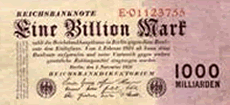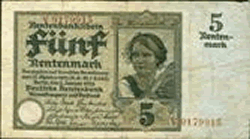Can Gold Do Now What The Rentenmark Did For Germany In 1923?
Commodities / Gold and Silver 2010 Nov 12, 2010 - 12:06 PM GMT
 What was a "Rentenmark"?
What was a "Rentenmark"?
At the left you see a one billion Mark note that was among the last printed notes of the Weimar Republic which saw the dreadful hyperinflation from the war's end to August 1923. At the right was a currency that replaced it and which helped terminate the hyperinflation that infested Europe, but was at its worst in Germany.
 This was at a time when gold was completely accepted as money internationally. Due to the economic crises in Germany after the Great War there was no gold available to back the currency. Therefore the Rentenbank in November 1923 issued the Rentenmark, a currency backed by mortgaged land and industrial goods worth 3.2 billion Rentenmark. The Rentenmark was pegged to the U.S. Dollar at a rate of 1 Dollar: 4.20 RM. At the end of the First World War, the Deutschmark was valued at 4.63 to the U.S. $. The rate of the Rentenmark to the Papiermark was 1:1,000,000,000,000 (1 trillion Papiermark). The Rentenmark was only an temporary currency and was not legal tender. It was, however, accepted by the population and effectively stopped the inflation. The Reichsmark became the new legal tender on 30 August 1924, equal in value to the Rentenmark.
This was at a time when gold was completely accepted as money internationally. Due to the economic crises in Germany after the Great War there was no gold available to back the currency. Therefore the Rentenbank in November 1923 issued the Rentenmark, a currency backed by mortgaged land and industrial goods worth 3.2 billion Rentenmark. The Rentenmark was pegged to the U.S. Dollar at a rate of 1 Dollar: 4.20 RM. At the end of the First World War, the Deutschmark was valued at 4.63 to the U.S. $. The rate of the Rentenmark to the Papiermark was 1:1,000,000,000,000 (1 trillion Papiermark). The Rentenmark was only an temporary currency and was not legal tender. It was, however, accepted by the population and effectively stopped the inflation. The Reichsmark became the new legal tender on 30 August 1924, equal in value to the Rentenmark.
Together with the responsible fiscal policy of Chancellor of Germany Gustav Stresemann and Finance Minister Hans Luther it brought the inflation in Germany to an end. The Rentenbank continued to exist after 1924 and the notes and coins continued to circulate. The last Rentenmark notes were valid until 1948.
Why did it work?
How could the German people so devastated by this abuse of un-backed paper money have accepted this new piece of paper? For a start no-one ever has a choice when it comes to everyday cash needs. Even when Zimbabwean notes were worthless, when they were printed with an expiry date, the people in that country were forced to use it, by government order. The Germans had developed all sorts of ways to bypass the use of this paper. And then the system had flopped. Well before then, foreigners had refused to accept German paper and the government had sold the German gold off overseas. So what made the German people accept this new paper currency? It was secured against something the people believed was unprintable and valuable, industrial goods and land. This appeared to strictly limit the volume of money that could be printed against it. It inspired confidence again. But a closer look showed why it was credible:
- It was national money issued by one bank against collateral that could be handed over in the event of its failure.
- There was one jurisdiction that imposed laws over the money and the assets involved.
- It was in a region where the issuers could be held accountable and holders of the paper were essentially government/ mortgage bank creditors.
Only workable at home
While it worked and inspired confidence, it only did so inside Germany! A foreigner would not have been welcome with such notes, to go to court against the government so he could seize the assets. To go up against a government on its turf is never wise. The national nature of the money limited it to within Germany's borders. Anybody seizing assets of Germany outside the country would have a chance, because the matter would have to be decided outside Germany's Jurisdiction, where the country would simply be a debtor of the foreigner. At that time, Germany did not have overseas assets anymore.
Currency, or government issued paper can only succeed when it is trusted and reliable. The moment it loses that trust and reliability as the Weimar Republic money had, it is worthless! Today such a scheme would not work because of the devastation or property values in so many parts of the world and the dangers that such values would fluctuate too much.
The World Bank suggests gold could act as a reference for currency values
Mr Robert Zoellick has set the cat amongst the pigeons this last week by suggesting that gold should be used as a reference point for currencies at the current time, a time when confidence in currencies is declining fast. Why did he choose gold, you may well ask? Yes, it has always been seen as money except for the last 40 years when the world has trusted the behavior of governments and their currencies. There is little chance that a Gold Standard could work in its past form that would be too restrictive of money supply. Beside the small quantity of gold available would make each piece of gold too valuable to make it a practical money. But that does not mean to say that gold could not do the job used in another way.
The head of the World Bank suggested it be used as a reference for currency values, not as money itself. This is entirely different. What virtues could gold bring to the monetary table?
- Gold is internationally accepted and held by central banks.
- The days when central banks implied they were going to sell their holdings and assisted the gold price to fall have passed. Central Banks are either holders or buyers of gold now.
- Gold is not vulnerable to a printing press.
- When economic decay sets in gold is not affected.
- Gold is not vulnerable to individual government action except within the Jurisdiction of that country.
- With national interests overriding international interests, international gold will remain respected money when currencies fail.
- As such in the international arena, gold's value will reflect the value of currencies, whether governments like it or not. As such a currency can be devalued or revalued against gold when comparison to another currency is inadequate [such as the dollar being valued against the euro - with both suffering one form of monetary decay or another].
Just as the Rentenmark anchored currency in a post-hyperinflation nation, gold can bring such an anchor to global money. It will be unpopular until it is sorely needed because of one or more major nation's profligate behavior regarding their own currencies. This has already started as we can see in the G-20 nation meeting of this week. The cautionary note is that it worked because the nation was desperate having exhausted all other alternatives. This desperation may be needed before gold takes on that role internationally. Then gold will value each currency at its internationally exchangeable value. In such a role, you can be sure that each national government will want to control the gold in its own Jurisdiction at some point in time!
Gold Forecaster regularly covers all fundamental and Technical aspects of the gold price in the weekly newsletter. To subscribe, please visit www.GoldForecaster.com
![]()
By Julian D. W. Phillips
Gold-Authentic Money
Copyright 2009 Authentic Money. All Rights Reserved.
Julian Phillips - was receiving his qualifications to join the London Stock Exchange. He was already deeply immersed in the currency turmoil engulfing world in 1970 and the Institutional Gold Markets, and writing for magazines such as "Accountancy" and the "International Currency Review" He still writes for the ICR.
What is Gold-Authentic Money all about ? Our business is GOLD! Whether it be trends, charts, reports or other factors that have bearing on the price of gold, our aim is to enable you to understand and profit from the Gold Market.
Disclaimer - This document is not and should not be construed as an offer to sell or the solicitation of an offer to purchase or subscribe for any investment. Gold-Authentic Money / Julian D. W. Phillips, have based this document on information obtained from sources it believes to be reliable but which it has not independently verified; Gold-Authentic Money / Julian D. W. Phillips make no guarantee, representation or warranty and accepts no responsibility or liability as to its accuracy or completeness. Expressions of opinion are those of Gold-Authentic Money / Julian D. W. Phillips only and are subject to change without notice.
Julian DW Phillips Archive |
© 2005-2022 http://www.MarketOracle.co.uk - The Market Oracle is a FREE Daily Financial Markets Analysis & Forecasting online publication.



